Liceo Classico Paolo Sarpi
| Liceo Classico Paolo Sarpi Una scuola nella storia d'Italia. Il Liceo 'Sarpi' 1803-2003 | |
|---|---|
 | |
 | |
|
The neoclassical façade of Sarpi palace, designed by Ferdinando Crivelli in 1842. The school was established in 1803. | |
| Address | |
|
Liceo Classico Paolo Sarpi | |
|
Piazza Rosate, 4 Upper City of Bergamo Bergamo, 24125 | |
| Coordinates | Bergamo 45°42′08″N 9°39′44″E / 45.7023°N 9.6622°E |
| Information | |
| Other name | Liceo Ginnasio Statale Paolo Sarpi |
| School type | Public liceo classico, high school |
| Motto |
Una scuola nella storia d'Italia. Sarpi 1803-2003 (Italian) (A school in the History of Italy) |
| Denomination | Liceo Classico Statale Paolo Sarpi |
| Established | 1803 |
| Category | Liceo classico |
| Grades | 5 |
| Age | 14 to 19 |
| Enrollment | 100-120 yearly |
| Average class size | 20-25 |
| Education system | Ministry of Education, Universities and Research (Italy) |
| Classes offered |
All compulsory: Ancient Greek language, literature and culture, Latin language, literature and culture, Philosophy, History, Italian literature, Mathematics, English literature, Art History, Physics, Biology, Natural Sciences, Geography, Chemistry, Earth Sciences, Computer Sciences and Physical education. Second Foreign Language and History of Music (optional). |
| Medium of language | Italian |
| Schedule type | 2 semesters or 4 trimesters |
| Hours in school day | 5-6 daily hours, six days per week |
| Campus type | Urban |
| National ranking | 2nd |
| Alumni | sarpini |
| Information | Named after Paolo Sarpi |
| Website | http://www.liceosarpi.bg.it/ |
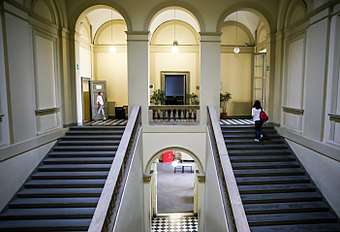
Liceo Classico Paolo Sarpi, known as Sarpi, is a public high school in Bergamo, Lombardy, northern Italy, and a leading academy (ranked 2nd nationally by Eduscopio in 2016 and 2017[1]) for students aged 14–19, due to the methodology and the plan of study combining Ancient Greek language and culture, Latin language and culture, Philosophy and History. The experiences of Sarpi students are the subject of the 2012 Italian documentary film Gli anni e i giorni.[2] Every year, some 100 students graduate from Sarpi, that is one of Italy's oldest humanistic, scientific and social high schools (founded in 1803). The school is located in the Città Alta, the Upper City of Bergamo.
The documentary-film Gli anni e i giorni (2012)
Some fifth-grade Sarpi students share their last school year experience in a documentary-film about the Italian Education System. Students live the delicate moment of transition to adulthood and they seek to balance both the uncertainties and expectations of their future.
Excellence at Sarpi: the 2015 National Report
Sarpi is considered an elitist high school and [3][4] a selective, harsh and competitive environment[5] and the enrolment decreased by 40% between 2015 and 2016.[6] A 2015 report of the Italian Ministry of Education[7] highlights that the numbers of drop-outs and failures at Sarpi are too high and must be reduced significantly.[8] Too many students (a quarter) do not pass classes, while others are conditionally allowed to advance to the next grade, only after re-taking failed exams over the summer. Students tend to enrol in other high schools, because of the higher chances to succeed. Strict school's policies too rarely allow teachers to assess students with top grades. Bright pupils at Sarpi are rarely graded 9 and 10 out of 10 but more often middle band grades 7 and 8 (with 6 out of 10 being the passing grade). This grading policy disfavours Sarpi scholars as compared to students of other Italian high schools, where teachers abide by the national grading system, ranging from 3 to 10. In 2016, the average grade at Sarpi was 6.98 out of 10 and 1% of Sarpi students had a GPA higher or equal than 9.[9] Although data show that grades awarded at Sarpi stand below the Italian average, the report highlights Sarpi students excellence. At the 2014 Ministerial National tests of Humanities and Scientific studies, the Institute performed far above Italian schools' average and Sarpi pupils were asked to re-take the tests, because results exceeded the expectations as compared to the National situation (INVALSI National tests 2014).[10][11] On the other hand, students in South Italy, who are less prepared but tend to get better grades as compared to Northern Italy,[12][13][14][15][16] came last in the INVALSI National tests.[17] This phenomenon is also known as Italy's North-South divide in school grading standards, and was described in the Italian Journal of Sociology of Education in 2015.[18]
In 2016, no scholars at Sarpi graduated with honours. On the contrary, South Italy holds the record of students graduated with honours: 944 in Apulia, 802 in Campania and 516 in Sicily.[19] About the competences, the report says that "the curriculum of this school is not meant for the world of work, rather to educate the future ruling class. Apprenticeships involving all students should be nonetheless implemented".[20]
History
The first public school of Grammar, Humanities, and Rhetorics dates back to 1506 and was renamed Accademia della Misericordia in 1566. It was abolished in 1610 and revived in 1617 as Nuova Accademia della Misericordia. Having collapsed because of the 1630 plague, the school was reopened with the name Collegio Mariano by Ambrogio Mariano, who in 1663 was charged of the restoration of the palace. In 1700, the Collegio Mariano was closed by Napoleon. The modern school was established during the Napoleonic epoch on the 15 November 1803. It was located in Via Arena. The Convento della Clarisse became the permanent location of the school in 1816. The convent was then demolished (1844). On the site, the current building was erected between 1845 and 1852. It was designed by the architect Ferdinando Crivelli. Following the Italian Unification, a 1865 royal decree ordered to name the school after Paolo Sarpi, a polymath of the Republic of Venice.
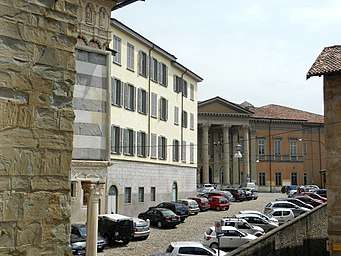
Recently, some reforms took place:
- in 1989 the Liceo adopted the continuation of foreign language learning in the triennium;
- in 1990 the Liceo adhered to the National Plan for Computer Sciences Learning;
- in 1996 it approved the experimentation of cultural heritage studies and history of art;
- the Hermes project (1998) was an experiment of autonomous pedagogy, to find new ways to develop recovery activities.
The palace as a movie setting
The palace and the surrounding areas have been used as setting of several movies:
- Call Me by Your Name (by Luca Guadagnino, 2017). Piazza Rosate and the courtyard of Sarpi were used as part of the movie setting of the 2017 romantic-drama film set in Lombardy. Among the other historical buildings, Bergamo Cathedral, Santa Maria Maggiore, and the University of Sciences, Letters and Arts were also used. [21]
- Una grande famiglia[22][23] (The Family, 2012-2015, by Riccardo Milani for Rai 1, flagship television channel of Italy's public broadcasting company Rai).
- Gli Anni e i Giorni[24] (by Beppe Manzi, 2012).
Notable alumni
- Claudia Ferrazzi, French President Emmanuel Macron's cultural advisor. Former director-general of Louvre Museum in Paris.[25]
- Giulio Terzi di Sant'Agata, former Italian Minister of Foreign Affairs. He served as Italy's ambassador to the United States from 2009 to 2011. Former Permanent representative of Italy to the United Nations, where he headed the Italian delegation to the United Nations Security Council.
- Filippo Maria Pandolfi, Italian politician, exponent of Christian Democracy, Minister of Agriculture, Minister of the Industry, twice Minister of Treasury. European commissioner for Research, Innovation and Science
- Roberto Calderoli, former vice president of the Italian Senate of the Republic
- Vittorio Feltri, Italian journalist
- Giorgio Gori, Mayor of Bergamo and exponent of Democratic Party
- Giacomo Suardo, President of the Senate of the Kingdom of Italy (1939-1943)
The architecture
Architectural description
U-shaped building with an irregular layout consisting of two and three storeys above ground level. The supporting walls are in plastered stone and bricks, the flat attics are in wood and the vaulted ones in brick. The pavilion roof has a wooden structure and mantle in roof tiles. Once through the monumental entrance located at the centre of the Neoclassical front, a large entrance hall leads into a quadrangular atrium supported by columns, where an imposing three-ramp staircase connects the atrium to the first floor. The front facing the quadrangular inner courtyard is free on one side and has a portico on the ground floor and a loggia on the upper floor.
Decorations-architectural details
The imposing façade of the building presents a pronaos (giant order) supported by four columns with Corinthian capitals resting on square bases; on the background wall you can see the architectural pattern with four pilasters of the same order and there are three entrance portals, two of which are now buffered. The opening frames and the decorative elements are in sandstone. There are traces of frescoes in the auditorium, once divided in two simple classrooms, nowadays returned to its original dimensions thanks to the demolition of the planks.
Relevant historical use
The building was erected on the area of the former monastery of S. Maria in Rosate (Franciscan followers), a religious order that was deleted in 1810. Two alternative locations for the building were studied: the area of the ‘small fort’ and in the Medolago building.
Restoration work
In 1883 the inner church had to be converted into a gym while in the second half of the XX century the science laboratories were renovated. In 1980- 82 the building underwent complete restoration.
Constraints
The Bergamo County Heritage Trust, which is a branch of the Ministry of Cultural Heritage (Milan), is committed to the conservation of the building. Therefore, any intervention must be authorized by them.[26]
The museum within the school
The school hosts a museum of Physics, Art and History that is run by students.
External links
- "Liceo Sarpi has to repeat the INVALSI tests: students are too smart" - L'eco di Bergamo 26 September 2013. http://www.ecodibergamo.it/stories/Cronaca/395452_sei_bravo_nel_test_allora_bari_il_sarpi_penalizzato_allinvalsi/
- Liceo Sarpi opens its museum of physics and literature. http://milano.repubblica.it/cronaca/2012/09/13/foto/fisica-42466922/1/
Pictures
 The skyline of the Upper City of Bergamo. The Liceo Classico Paolo Sarpi palace is on the left of the picture.
The skyline of the Upper City of Bergamo. The Liceo Classico Paolo Sarpi palace is on the left of the picture.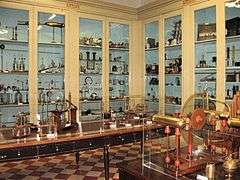 Physics Laboratory
Physics Laboratory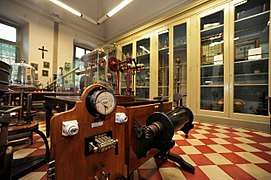 Physics Laboratory
Physics Laboratory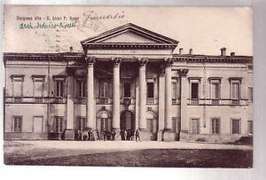 The building
The building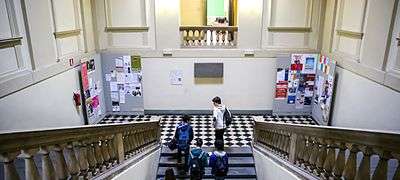 The staircase
The staircase
School subjects and plan of study
In 2010, the Gelmini reform changed the traditional Italian school system, so now students follow this specific pattern of courses that covers a large range of disciplines:
- Italian grammar and literature (all five years)
- History (all five years)
- Latin language, grammar (the two years of ginnasio) and literature (the three years of liceo)
- Ancient Greek language, grammar (the two years of ginnasio) and literature (the three years of liceo)
- Mathematics (all five years)
- History of Art (three years, during the liceo; still, some high schools offer a five-year, in-depth history of art program)
- Philosophy (the three years of liceo)
- Physics (the three years of liceo)
- Biology, chemistry and natural science (all five years)
- English grammar (all five years) and literature (the three years of liceo)
- Catholic religion instruction (optional)
- Physical education (all five years)
- Geography (two years, during the ginnasio)
However, nowadays it is common to find licei offering (together with this programme of studies) courses in music theory and history of music or an in-depth course in science or maths, for one or two hours a week every year.
Upon the completion of the studies, students must pass the Esame di Stato (until 1999 denominated Esame di maturità) to obtain their diploma di maturità.
| Subjects | Gymnasium | Lyceum | |||
|---|---|---|---|---|---|
| I year | II year | III year | IV year | V
year | |
| Italian language and literature | 4 | 4 | 4 | 4 | 4 |
| Latin language, literature, civilization | 5 | 5 | 4 | 4 | 4 |
| Ancient Greek language, literature, civilization | 4 | 4 | 3 | 3 | 3 |
| English | 3 | 3 | 3 | 3 | 3 |
| History and geography | 3 | 3 | - | - | - |
| History | - | - | 3 | 3 | 3 |
| Philosophy | - | - | 3 | 3 | 3 |
| Mathematics* | 3 | 3 | 2 | 2 | 2 |
| Physics | - | - | 2 | 2 | 2 |
| Natural science** | 2 | 2 | 2 | 2 | 2 |
| History of art | - | - | 2 | 2 | 2 |
| Physical education | 2 | 2 | 2 | 2 | 2 |
| Catholic religion instruction or other activities[27] | 1 | 1 | 1 | 1 | 1 |
| Weekly lesson hours | 27 | 27 | 31 | 31 | 31 |
- *with computer lab at first biennial
- **Biology, chemistry and earth science
Second Foreign Language and History of Music (optional). Speciality of Maths offered as well during the final three years of Liceo.
References
- ↑ (PDF) http://www.liceosarpi.bg.it/wp-content/uploads/2015/10/Rapporto-di-AutoValutazione-del-Liceo-Sarpi.pdf. Missing or empty
|title=(help) - ↑ Manzi, Beppe (2012-12-18), Gli anni e i giorni, retrieved 2017-10-02
- ↑ "Il Classico non è di moda La fuga dal liceo degli studenti bergamaschi - Bergamo News". BergamoNews (in Italian). 2013-08-23. Retrieved 2017-10-17.
- ↑ "Liceo Classico Paolo Sarpi di Bergamo". Opinioni degli studenti. Retrieved 2017-10-17.
- ↑ "Liceo Classico Paolo Sarpi di Bergamo". Opinioni degli studenti. Retrieved 2017-10-15.
- ↑ "Sarpi, che ti succede? Sempre meno iscritti, serve un cambiamento netto - Bergamo News". BergamoNews (in Italian). 2016-05-09. Retrieved 2017-10-14.
- ↑ "RAV rapporto di autovalutazione - Liceo Classico Statale Paolo Sarpi" (PDF). Retrieved 27 November 2015.
- ↑ "RAV Certificato di autovalutazione 2015" (PDF). 2015.
- ↑ (PDF) http://www.liceosarpi.bg.it/wp-content/uploads/2014/08/analisi-risultati-16-17.pdf. Missing or empty
|title=(help) - ↑ "RAV - rapporto di autovalutazione - Liceo Classico Sarpi 2015" (PDF).
- ↑ "RAV 2015 - Rapporto di autovalutazione Sarpi" (PDF).
- ↑ http://ricerca.repubblica.it/repubblica/archivio/repubblica/2014/08/06/perche-i-voti-sono-piu-alti-al-sud28.html. Missing or empty
|title=(help) - ↑ http://archivio.panorama.it/opinioni/redazione/Ricolfi-Gli-studenti-del-Sud-hanno-voti-piu-alti-ma-sono-meno-preparati. Missing or empty
|title=(help) - ↑ http://www.flcgil.it/rassegna-stampa/nazionale/voti-piu-alti-alla-maturita-al-sud-capiremo-perche-valutando-i-prof.flc. Missing or empty
|title=(help) - ↑ http://noisefromamerika.org/articolo/perche-studenti-sud-ottengono-voti-piu-alti-maturita. Missing or empty
|title=(help) - ↑ http://iltirreno.gelocal.it/italia-mondo/2017/08/04/news/maturita-2017-i-voti-piu-alti-al-sud-1.15694341. Missing or empty
|title=(help) - ↑ "Maturità, al Sud è record di 100 e lode ma studenti meridionali ultimi in prove Invalsi. Zaia: 'Ragazzi del Nord penalizzati' - Il Fatto Quotidiano". Il Fatto Quotidiano (in Italian). 2016-08-12. Retrieved 2017-10-14.
- ↑ "The North-South Divide in School Grading Standards: New Evidence from National Assessments of the Italian Student Population" (PDF).
- ↑ (PDF) http://www.liceosarpi.bg.it/wp-content/uploads/2014/08/analisi-risultati-16-17.pdf. Missing or empty
|title=(help) - ↑ "RAV 2015 - Liceo Classico Paoo Sarpi" (PDF).
- ↑ Spagnuolo, Eugenio (2018-01-26). "Chiamami col tuo nome: i luoghi dove è stato girato il film di Guadagnino - Panorama". Panorama (in Italian). Retrieved 2018-07-26.
- ↑ IlTognis (2012-04-20), Sprangate al Liceo Sarpi-reportage della fiction di rai1 "una grande famiglia", retrieved 2017-10-15
- ↑ The Family, Sonia Bergamasco, Emmanuel Dabone, Filippo De Paulis, retrieved 2017-10-10
- ↑ Manzi, Beppe (2012-12-18), Gli anni e i giorni, retrieved 2017-10-03
- ↑ magazine, Le Point, (2017-05-26). "Qui est Claudia Ferrazzi, la conseillère culture d'Emmanuel Macron ?". Le Point (in French). Retrieved 2017-10-03.
- ↑ (PDF) ftp://ftp.provincia.bergamo.it/Cultura/POI_MUSEI/VillePalazzi/069/EN069.pdf. Missing or empty
|title=(help) - ↑ namely, for students who decide not to follow this course